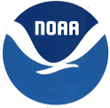 Customer: Office of Science and Technology (OST), National Oceanic and Atmospheric Administration (NOAA), U.S. Department of Commerce (DOC)
Customer: Office of Science and Technology (OST), National Oceanic and Atmospheric Administration (NOAA), U.S. Department of Commerce (DOC)
(Fairfield Technologies, prime contractor)
Goal: Provide integrated data and analysis capabilities for a network of sophisticated local, regional, and national offices, allowing production of timely and accurate weather analyses, forecasts and warnings.
Application: Design and Build a Prototype Grid In A Box Software Product for NOAA, using grid computing and ontologies (rigorously-defined knowledge structures that describe data and relationships within a given subject area) together to enable communication between NOAA computer systems, regardless of underlying technologies.
Challenges: NOAA’s objective is similar in nature to DoD and intelligence mission challenges: connecting people, sensors, systems and control networks to integrate and evaluate data, accelerating decision speed and accuracy, providing decision superiority that protects our country and saves lives. Challenges include:
- Complex data challenges:
- High volume, continuous production, observed, forecast data
- Measures different weather, climate, atmospheric, and scientific variables
- Wide variety of missions (e.g. NWS, NOS, NESDIS, Fisheries, Research, etc.), sources, products, formats, encoding, presentations
- Data, analysis, and computational power are fragmented, due to normal system architecture and weather product evolution
As in most systems environments, there is also a dynamic tension between budget constraints and mission growth
FTI’s Approach:
Leveraging open source technology and cutting-edge R&D from leading institutions (e.g. Livermore, Argonne, Caltech, UCSD, CERN), FTI has successfully designed, built, tested and benchmarked the platform-independent, open source, standards-based “Grid In A Box” prototype product within the standard NWS computing environment (Intel, Red Hat Enterprise Linux, Java J2EE, visual user interface, Service Oriented Architecture [SOA]).Meteorologists and hydrologists use existing software tools and programs in specific sequences to analyze, evaluate, and forecast weather data. Using Grid In A Box drop down menus and a drag-and drop visual workflow interface, NOAA scientists (who may not be programmers) can better manage their technical and analytical workflow, and easily add grid computing capabilities to existing legacy applications without re-writing any legacy code. Security is provided via technology (e.g. X.509 certificates), organizational policies and procedures. The product can be easily integrated into existing systems (including multi-core processors).
Early benchmarks show potentially significant (30-50%) performance improvements. However, actual improvements achieved will vary based on hardware, configuration, number of computing nodes, and specific application processing characteristics.
Advantages over competing solutions include:
- Ability to quickly deploy “mobile self-contained grids” to forward or remote operating locations, reducing overall communications bandwidth needs
- Visual workflow interface improves operations, not just computing
- Easy to deploy and operate
- “Mini-grids” can provide high-performance computing to small departments and workgroups, improving computational speed for specific critical processes.
Products Used:HP, Red Hat Enterprise Linux, Fedora Core, Java, J2EE, XML, Globus Toolkit, Java Swing, JGo, JSP, Java Beans, servlets
Benefits:
- Better System Utilization – Organizing and harnessing pools of underutilized computing resources to solve large, complex weather-related problems
- Improved Collaboration and Cooperation – Provide capability to easily reorganize work and data flows across organization and system boundaries, allowing increased collaboration on common problems and sharing applications and data within mission “communities of interest”
- Increased Budget Efficiencies – Leveraging significant legacy IT investments and accomplishments to provide a next-generation, large scale High Performance Computing capability more economically than buying new systems
Delivery: On time, within budget. Used Lean Six Sigma techniques. Formally certified as a CMMI Level 3 project.


